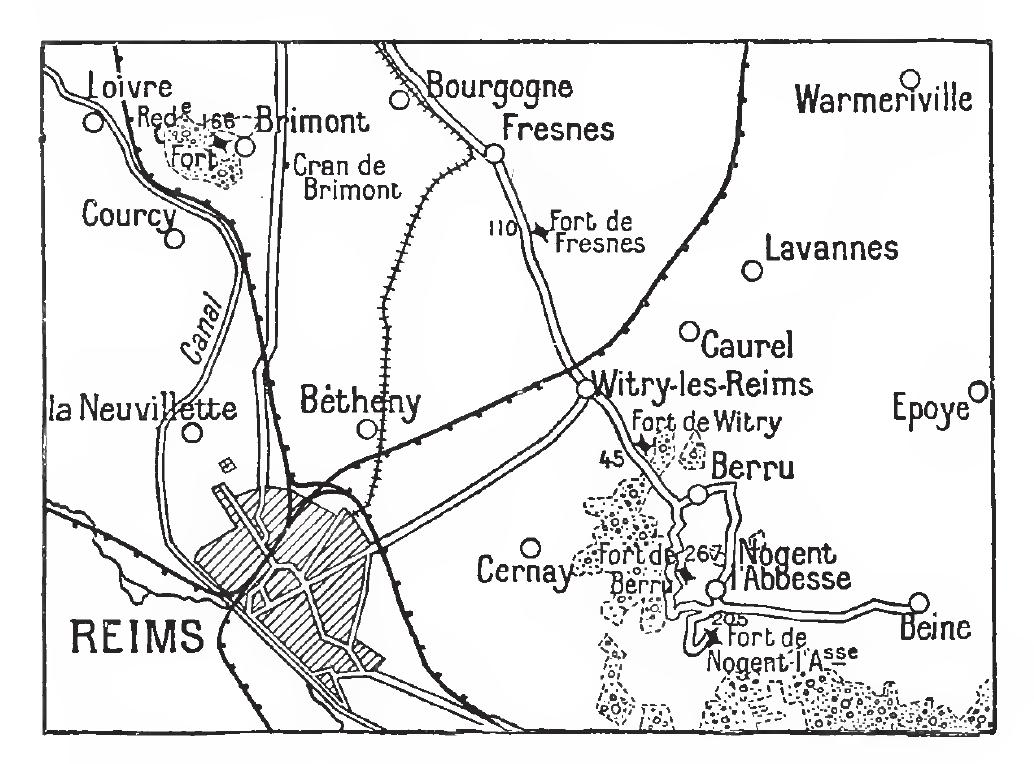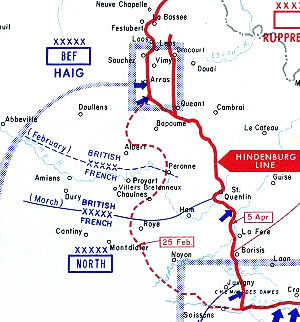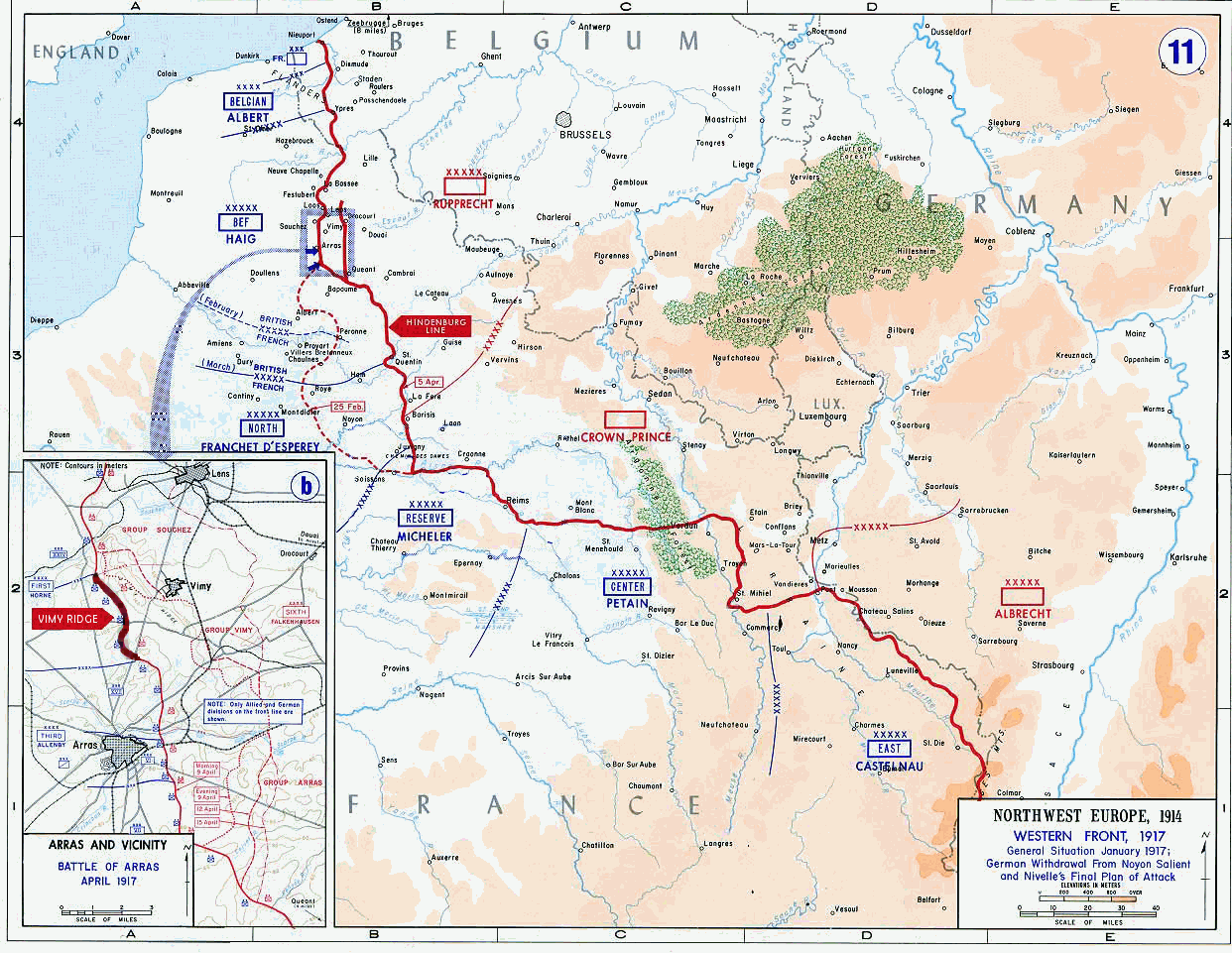|
Nivelle Offensive
The Nivelle offensive (16 April – 9 May 1917) was a Franco-British operation on the Western Front in the First World War which was named after General Robert Nivelle, the commander-in-chief of the French metropolitan armies, who led the offensive. The French part of the offensive was intended to be strategically decisive by breaking through the German defences on the Aisne front within with casualties expected to be around A preliminary attack was to be made by the French Third Army at St Quentin and the British First, Third and Fifth armies at Arras, to capture high ground and divert German reserves from the French fronts on the Aisne and in Champagne. The main offensive was to be delivered by the French on the Chemin des Dames ridge (the Second Battle of the Aisne). A subsidiary attack was to be made by the Fourth Army (the Third Battle of Champagne). The final stage of the offensive was to follow the meeting of the British and French armies, having broken through the Ger ... [...More Info...] [...Related Items...] OR: [Wikipedia] [Google] [Baidu] |
Western Front (World War I)
The Western Front was one of the main theatres of war during the First World War. Following the outbreak of war in August 1914, the German Army opened the Western Front by invading Luxembourg and Belgium, then gaining military control of important industrial regions in France. The German advance was halted with the Battle of the Marne. Following the Race to the Sea, both sides dug in along a meandering line of fortified trenches, stretching from the North Sea to the Swiss frontier with France, which changed little except during early 1917 and in 1918. Between 1915 and 1917 there were several offensives along this front. The attacks employed massive artillery bombardments and massed infantry advances. Entrenchments, machine gun emplacements, barbed wire and artillery repeatedly inflicted severe casualties during attacks and counter-attacks and no significant advances were made. Among the most costly of these offensives were the Battle of Verdun, in 1916, with a combined 700,000 ... [...More Info...] [...Related Items...] OR: [Wikipedia] [Google] [Baidu] |
Battle Of The Hills
The Battle of the Hills (french: link=no, Bataille des Monts) also known as the Battle of the Hills of Champagne and the Third Battle of Champagne, was a battle of the First World War that was fought from April–May 1917. The French Fourth Army offensive against the German 4th Army was to support the (GAN, Northern Army Group) along the Chemin des Dames, in the Second Battle of the Aisne. General Anthoine, commander of the Fourth Army planned a supporting attack but this was rejected by Nivelle and Anthoine planned a frontal attack by two corps on an front, to break through the German defences on the first day and commence exploitation the following day. The battle took place east of Reims, between Prunay and Aubérive, in the province of Champagne, along the Moronvilliers Hills. On the left of XII Corps to the east of the Suippes river, the 24th Division established a flank guard by attacking through Bois des Abattis towards Germains and Baden-Baden trenches. On the left ... [...More Info...] [...Related Items...] OR: [Wikipedia] [Google] [Baidu] |
Battle Of Cambrai (1917)
The Battle of Cambrai (Battle of Cambrai, 1917, First Battle of Cambrai and ''Schlacht von Cambrai'') was a British attack in the First World War, followed by the biggest German counter-attack against the British Expeditionary Force (BEF) since 1914. The town of Cambrai, in the département of Nord, in France, was an important supply centre for the German (known to the British as the Hindenburg Line) and capture of the town and the nearby Bourlon Ridge would threaten the rear of the German line to the north. Major General Henry Tudor, Commander, Royal Artillery (CRA), of the 9th (Scottish) Division, advocated the use of new artillery-infantry tactics on his sector of the front. During preparations, J. F. C. Fuller, a staff officer with the Tank Corps, looked for places to use tanks for raids. General Julian Byng, commander of the Third Army, decided to combine both plans. The French and British armies had used tanks en masse earlier in 1917, although to considerably less ef ... [...More Info...] [...Related Items...] OR: [Wikipedia] [Google] [Baidu] |
Third Battle Of Ypres
The Third Battle of Ypres (german: link=no, Dritte Flandernschlacht; french: link=no, Troisième Bataille des Flandres; nl, Derde Slag om Ieper), also known as the Battle of Passchendaele (), was a campaign of the First World War, fought by the Allies against the German Empire. The battle took place on the Western Front, from July to November 1917, for control of the ridges south and east of the Belgian city of Ypres in West Flanders, as part of a strategy decided by the Allies at conferences in November 1916 and May 1917. Passchendaele lies on the last ridge east of Ypres, from Roulers (now Roeselare), a junction of the Bruges-(Brugge)-to-Kortrijk railway. The station at Roulers was on the main supply route of the German 4th Army. Once Passchendaele Ridge had been captured, the Allied advance was to continue to a line from Thourout (now Torhout) to Couckelaere (Koekelare). Further operations and a British supporting attack along the Belgian coast from Nieuport ( Nieuwpoor ... [...More Info...] [...Related Items...] OR: [Wikipedia] [Google] [Baidu] |
Battle Of Messines (1917)
The Battle of Messines (7–14 June 1917) was an attack by the British Second Army (General Sir Herbert Plumer), on the Western Front, near the village of Messines (now Mesen) in West Flanders, Belgium, during the First World War. The Nivelle Offensive in April and May had failed to achieve its more grandiose aims, had led to the 1917 French Army mutinies, demoralisation of French troops and confounded the Anglo-French strategy for 1917. The attack forced the Germans to move reserves to Flanders from the Arras and Aisne fronts, relieving pressure on the French. The British tactical objective was to capture the German defences on the ridge, which ran from Ploegsteert Wood (Plugstreet to the British) in the south, through Messines and Wytschaete to Mt Sorrel, depriving the German 4th Army (German Empire), 4th Army of the high ground. The ridge gave commanding views of the British defences and back areas of Ypres to the north, from which the British intended to conduct the North ... [...More Info...] [...Related Items...] OR: [Wikipedia] [Google] [Baidu] |
Battle Of La Malmaison
The Battle of La Malmaison () from 23 to 27 October, was the final French action of the 1917 campaign in the First World War, which had begun with the Nivelle Offensive. The French captured the village and fort of La Malmaison and took control of the Chemin des Dames ridge. The German 7th Army (General Max von Boehn) had discovered French preparations for the attack and also identified the date and time. Boehn chose to defend the front positions, rather than treat them as an advanced zone and to conduct the main defence north of the Oise–Aisne Canal. The German artillery was outnumbered three-to-one and on the front of the 14th Division, batteries were confronted by which silenced most of the German guns before the attack. Gas from French bombardments on low-lying land near the Oise–Aisne Canal in the Ailette valley, became so dense that it was impossible to carry ammunition and supplies forward or to remove the wounded. Battalions from specialist German counter-attack ... [...More Info...] [...Related Items...] OR: [Wikipedia] [Google] [Baidu] |
Reims
Reims ( , , ; also spelled Rheims in English) is the most populous city in the French department of Marne, and the 12th most populous city in France. The city lies northeast of Paris on the Vesle river, a tributary of the Aisne. Founded by the Gauls, Reims became a major city in the Roman Empire. Reims later played a prominent ceremonial role in French monarchical history as the traditional site of the coronation of the kings of France. The royal anointing was performed at the Reims Cathedral, Cathedral of Reims, which housed the Holy Ampulla of chrism allegedly brought by a white dove at the baptism of Frankish king Clovis I in 496. For this reason, Reims is often referred to in French as ("the Coronation City"). Reims is recognized for the diversity of its heritage, ranging from Romanesque architecture, Romanesque to Art Deco, Art-déco. Reims Cathedral, the adjacent Palace of Tau, and the Abbey of Saint-Remi were listed together as a UNESCO World Heritage Site in 1991 ... [...More Info...] [...Related Items...] OR: [Wikipedia] [Google] [Baidu] |
Moronvilliers
In 1911, the small village of Moronvilliers had 86 inhabitants. thumb On 2 September 1914, in the first month of World War I, the village, only 15 kilometers north-east from Rheims, was occupied by German troops. Situated on the frontline, the village was deserted and destroyed during the war. The village was never rebuilt after the war. On June 17, 1950, part of its territory was merged with that of Pontfaverger, which changed its name to Pontfaverger-Moronvilliers. Other parts were added to Saint-Hilaire-le-Petit Saint-Hilaire-le-Petit () is a commune in the Marne department in north-eastern France France (), officially the French Republic ( ), is a country primarily located in Western Europe. It also comprises of overseas regions and terri ... and Saint-Martin-l'Heureux. [...More Info...] [...Related Items...] OR: [Wikipedia] [Google] [Baidu] |
Philippe Pétain
Henri Philippe Benoni Omer Pétain (24 April 1856 – 23 July 1951), commonly known as Philippe Pétain (, ) or Marshal Pétain (french: Maréchal Pétain), was a French general who attained the position of Marshal of France at the end of World War I, during which he became known as The Lion of Verdun (french: le lion de Verdun). From 1940 to 1944, during World War II, he served as head of the collaborationist regime of Vichy France. Pétain, who was 84 years old in 1940, remains the oldest person to become the head of state of France. During World War I, Pétain led the French Army to victory at the nine-month-long Battle of Verdun. After the failed Nivelle Offensive and subsequent mutinies he was appointed Commander-in-Chief and succeeded in repairing the army's confidence. Pétain remained in command for the rest of the war and emerged as a national hero. During the interwar period he was head of the peacetime French Army, commanded joint Franco-Spanish operations during the ... [...More Info...] [...Related Items...] OR: [Wikipedia] [Google] [Baidu] |
French Army Mutinies (1917)
The 1917 French Army mutinies took place amongst French Army troops on the Western Front in Northern France during World War I. They started just after the unsuccessful and costly Second Battle of the Aisne, the main action in the Nivelle Offensive in April 1917. The new French commander of the armies in France, General Robert Nivelle had promised a decisive victory over the Germans in 48 hours; morale in French armies rose to a great height and the shock of failure soured their mood overnight. The mutinies and associated disruptions involved, to various degrees, nearly half of the French infantry divisions stationed on the Western Front. The term "mutiny" does not precisely describe events; soldiers remained in trenches and were willing to defend but refused orders to attack. Nivelle was sacked and replaced by General Philippe Pétain, who restored morale by talking to the men, promising no more suicidal attacks, providing rest and leave for exhausted units and moderating discip ... [...More Info...] [...Related Items...] OR: [Wikipedia] [Google] [Baidu] |
Battle Of Vimy Ridge
The Battle of Vimy Ridge was part of the Battle of Arras, in the Pas-de-Calais department of France, during the First World War. The main combatants were the four divisions of the Canadian Corps in the First Army, against three divisions of the German 6th Army. The battle took place from 9 to 12 April 1917 at the beginning of the Battle of Arras, the first attack of the Nivelle Offensive, which was intended to attract German reserves from the French, before the French attempt at a decisive offensive on the Aisne and the Chemin des Dames ridge further south, several days later. The Canadian Corps were to capture the German-held high ground of Vimy Ridge, an escarpment on the northern flank of the Arras front. This would protect the First Army and the Third Army farther south from German enfilade fire. Supported by a creeping barrage, the Canadian Corps captured most of the ridge during the first day. The village of Thélus fell during the second day, as did the crest of th ... [...More Info...] [...Related Items...] OR: [Wikipedia] [Google] [Baidu] |
Battle Of Arras (1917)
The Battle of Arras (also known as the Second Battle of Arras) was a British Empire, British offensive on the Western Front (World War I), Western Front during the First World War. From 9 April to 16 May 1917, British troops attacked German Empire, German defences near the French Third Republic, French city of Arras on the Western Front. The British achieved the longest advance since trench warfare had begun, surpassing the record set by the French Sixth Army (France), Sixth Army on 1 July 1916. The British advance slowed in the next few days and the German defence recovered. The battle became a costly stalemate for both sides and by the end of the battle, the British Third Army (United Kingdom), Third Army and the First Army (United Kingdom), First Army had suffered about 160,000 casualties and the German 6th Army (German Empire), 6th Army about 125,000. For much of the war, the opposing armies on the Western Front were at stalemate, with a continuous line of Trench warfare, tre ... [...More Info...] [...Related Items...] OR: [Wikipedia] [Google] [Baidu] |










